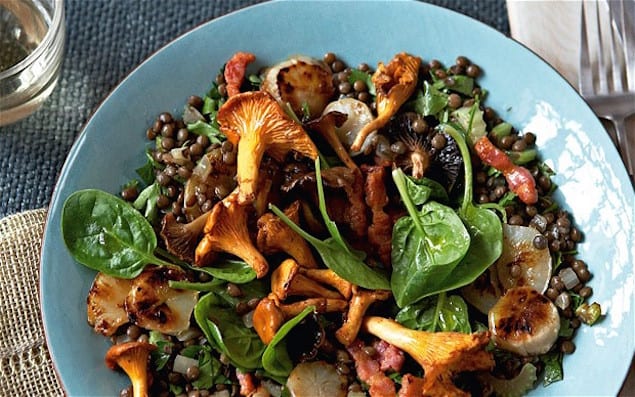A great digestion aid, making your own kimchi is easy and a deliciously spicy condiment to have on hand.
By Shannon Lim
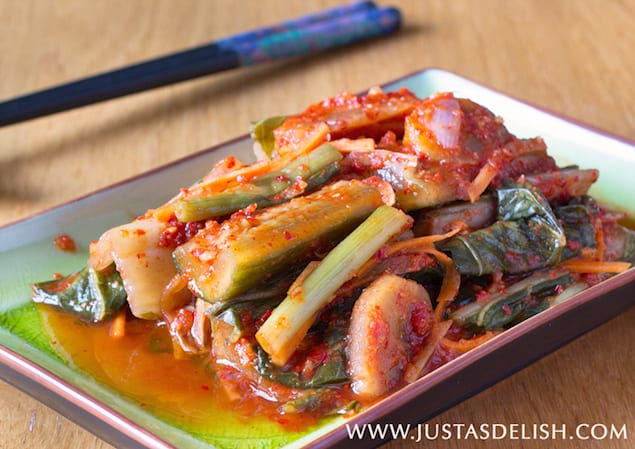
Bacteria are our friends.
When we eat fermented foods, we eat the beneficial bacteria – the probiotics – that the food contains. Some functions of probiotics are helping regular bowel movements, improving digestion, enhancing immune function, producing antioxidants and normalizing skin conditions. Eating fermented foods that contain natural, good bacteria helps boost the number and variety of bacteria living in our gut. It is almost like taking probiotic supplements, except it is delicious and far less expensive. Taking a large variety of fermented foods helps to populate your digestive system with a variety of microorganisms. Some examples of fermented foods that are widely available are plain yogurt, miso, tempeh, pickles, sauerkraut, kefir, kimchi, and kombucha. If you get them from the store, check the labels to make sure they do not contain any artificial stuff like preservatives.
Kimchi has been on my To-Do recipe list for the longest time. The process somehow seems quite intimidating, it must have been watching too many Korean drama series with the scenes of Korean women making kimchi by the hundreds of cabbage, with spicy red paste covering their gloved hands.
When most people hear the word kimchi, they think of fermented spicy, red-orange shards of napa cabbage that is almost always served in Korean restaurants. In fact, there are over 100 known varieties in Korea.
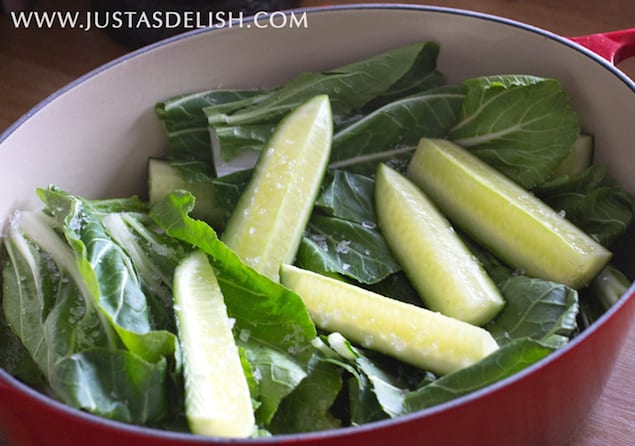
One benefit that is for sure, is that fermented food like kimchi aids our digestion. The process of kimchi fermentation creates the healthy bacteria, Lactobacillus (the source of probiotics), which is required by the body to keep a healthy state of intestinal flora.
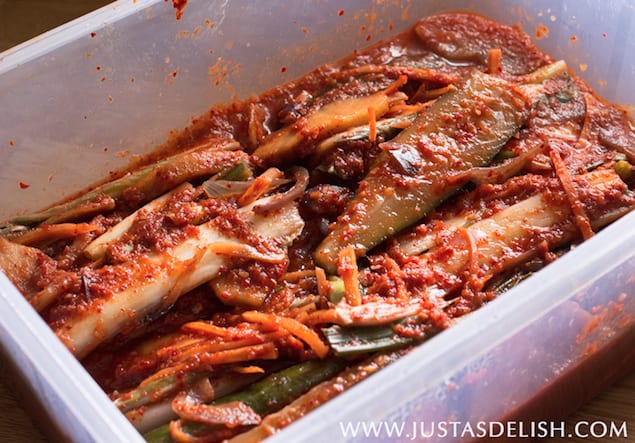
This recipe uses fruits like apple or pear in the seasoning, instead of the ‘glutinous rice porridge’ paste that is normally used in traditional napa cabbage kimchi. Even though my version is simplified, I do know now that this stuff is easy to make and darn tasty.
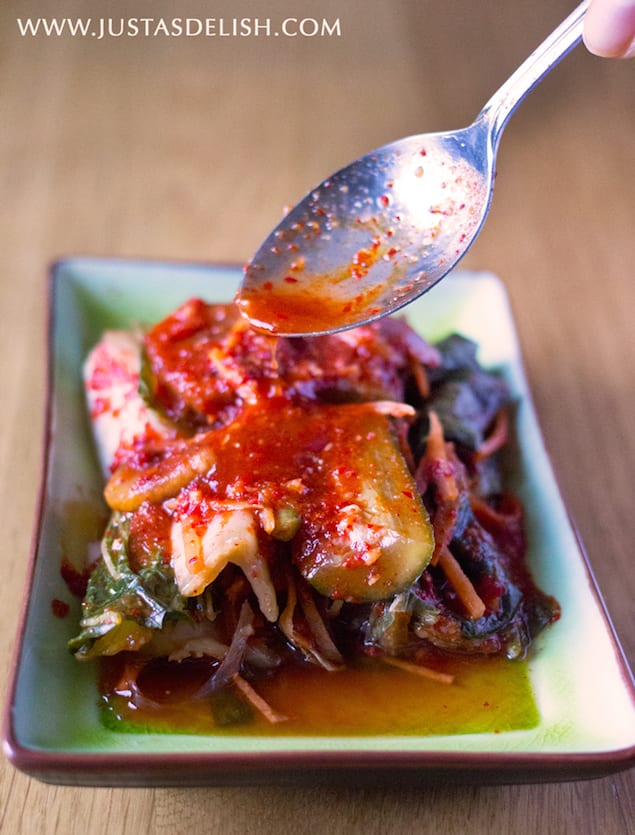
Bok Choy Kimchi
Description
A great digestion aid, making your own kimchi is easy and a deliciously spicy condiment to have on hand.
Ingredients
- 500g Bok Choy – separate the leaves and wash
- 1 large Japanese Cucumber (or 2 small)
- 2 tablespoon Seasalt
- 1 medium Carrot – cut into 5cm thin strips
- 3 Green Onions – cut into 5cm pieces
- 1 Red Apple (or Pear) – peeled
- ¼ Red Onion
Seasoning
- 1 clove Garlic
- 1cm Ginger
- 2 tablespoon Gochugaru (Korean Red Pepper Flakes)
- ½ Red Capsicum
- ½ Red Apple – peeled
- ¼ Red Onion
- 1 tablespoon fish sauce
Tools
- 2 large non-reactive bowls or pots
- 1 large colander
- Food grade gloves
- 3–4 liters airtight container or jar
Instructions
- Cut up bok choy (including stems) into bite-sized pieces (5-7cm pieces). Cut cucumbers into halves and long spears.
- In a large non-reactive bowl/pot, lay down a layer of bok choy and cucumber pieces, and sprinkle some salt. Add another layer and sprinkle some more salt, and so on until the 2 tablespoon finishes. Let it sit in room temperature for 3-4 hours. This will draw out water from the boy choy leaves and cucumber pieces creating a natural brine.
- Just before the 3-4 hours is up, place garlic, ginger, ¼ onion, ½ peeled apple, capsicum in a food processor or blender and puree until completely smooth.
- Cut 1 whole peeled apple into thin slices. And cut ½ onion into thin, long slices. Cut carrot into thin strips. Finally, cut green onions into 5cm pieces.
- After 3-4 hours, rinse and wash away the excess salt from the salted bok choy and cucumbers. After all of the excess salt has been rinsed out, gently squeeze out excess water from the vegetables with your hands.
- Place the vegetables in a large mixing bowl. Add 1 tablespoon salt and gochugaru to the bok choy and cucumbers. Wear gloves and mix well using your hands.
- Add the puree and fish sauce. Mix well until well incorporated.
- Add sliced pear, apple, and onion. Mix. Add green onion pieces. Mix gently.
- Pack the finished product into a big glass jar/container. Try to pack it tightly by pressing down as you are transferring it to the container. Make sure all of the kimchi juice and bits are transferred. Leave some room at the top of the jar – about 2 inches should suffice. If you don’t leave some room, kimchi liquid will bubble over and make a mess as it ferments.
- Leave the jar out in room temperature for about 48 hours depending on the room temperature and preference. It will take longer time in cooler temperature. Use a wooden spoon to press down the veggies, and there should be bubbles coming from the brine. Then the fermentation is complete. It should smell and taste sour. Refrigerate and store up to 2-3 weeks.. Serve chilled as side dish or use them in recipes.
Notes
Gochugaru (Korean Red Pepper Flakes) comes in a big packets, the smallest I’ve seen sold in Korean shops are in 500g packs. After opening a bag, keep them in the freezer to maintain its freshness.
- Category: Side, Condiment
- Cuisine: Korean












